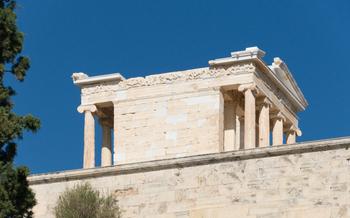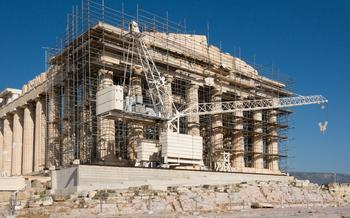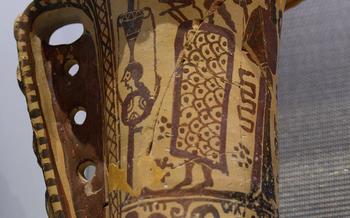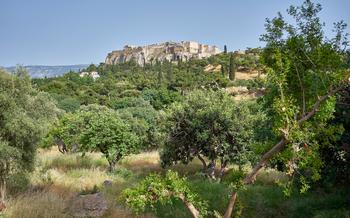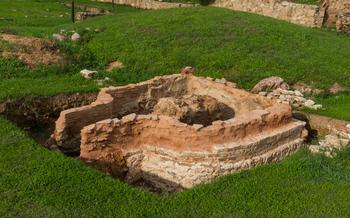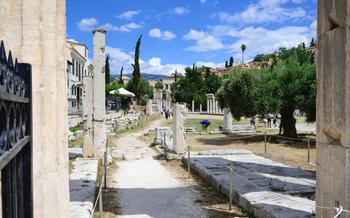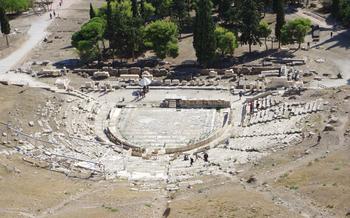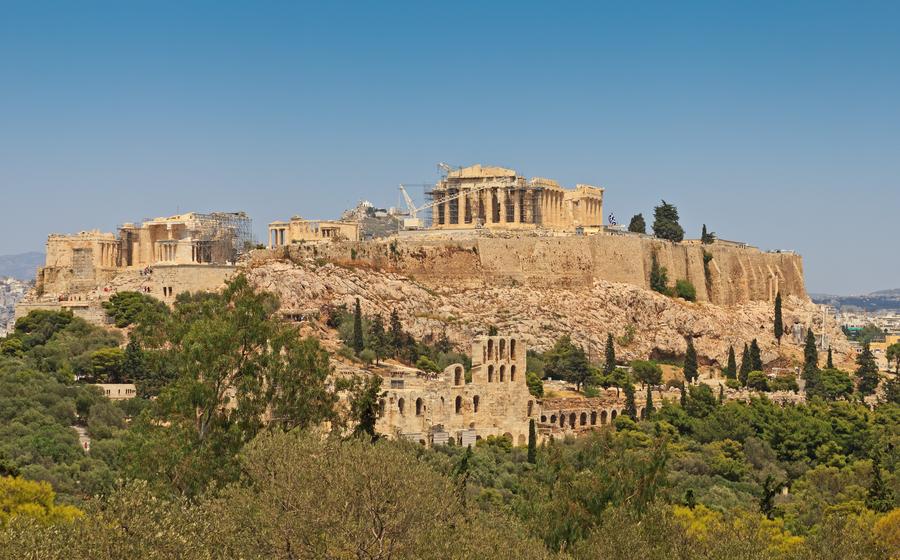
Acropolis of Athens
- A Journey Through History: Unveiling the Acropolis of Athens
- Ascending to the Acropolis: A Path to Enchantment
- The Parthenon: A Masterpiece of Architecture
- The Caryatids: Guardians of the Erechtheion
- The Temple of Athena Nike: A Winged Victory
- The Acropolis Museum: Unveiling the Treasures
- The Odeon of Herodes Atticus: Music Under the Stars
- The Dionysian Theatre: Where Drama Unfolded
- The Areopagus Hill: A Place of Judgment
- The Philopappos Monument: Honoring a Roman Citizen
- The Cave of Apollo: A Mythological Retreat
- The Agora of Athens: The Heart of the City
- Insider Tip: Best Time to Visit the Acropolis
A Journey Through History: Unveiling the Acropolis of Athens
The Acropolis of Athens stands as a testament to the grandeur of ancient Greek civilization. Perched atop a rocky hill overlooking the modern metropolis, this iconic site is a journey through history, embodying the essence of classical antiquity and its profound influence on Western culture. As you explore the Acropolis, you'll be immersed in the ruins of ancient temples, marvel at architectural wonders, and delve into the stories of gods, heroes, and philosophers that shaped the foundations of Western civilization.
The Acropolis was once the religious and political center of Athens, housing sacred temples, theaters, and administrative buildings. It was here that the Parthenon, a masterpiece of Doric architecture, was built as a tribute to the goddess Athena. The Erechtheion, with its iconic Caryatid porch, stands as a testament to the ingenuity of ancient Greek architects. These monuments, along with the Temple of Athena Nike and the Propylaea, the grand entrance gate, form an ensemble of architectural masterpieces that evoke awe and admiration.
The Acropolis is not only a symbol of ancient Greek heritage but also a UNESCO World Heritage Site, recognized for its outstanding universal value. It represents the pinnacle of artistic achievement, architectural brilliance, and the birthplace of democracy. As you wander through its ruins, you'll feel a connection to the past, transported back to a time when gods and heroes walked among mortals, shaping the destiny of a civilization that would leave an indelible mark on the course of human history.
Ascending to the Acropolis: A Path to Enchantment
The ascent to the Acropolis is a journey through time, a pilgrimage to the heart of ancient Athens. As you climb the worn stone steps of the sacred way, lined with olive trees and ancient ruins, you'll feel the weight of history upon your shoulders. The sacred way was once thronged with pilgrims and worshippers, making their way to the temples and sanctuaries that crowned the hill.
At the top of the stairs, you'll be greeted by the Propylea, a grand gateway that served as the entrance to the Acropolis. Its towering columns and intricate carvings hint at the architectural marvels that await you within. Step through the Propylea, and you'll be rewarded with breathtaking views of Athens and the surrounding countryside. The city stretches out before you, a tapestry of whitewashed buildings, ancient ruins, and sparkling blue sea.
The Acropolis offers a truly awe-inspiring experience, a chance to connect with the past and feel the vibrant spirit of ancient Greece. As you wander among the ruins, you'll be transported back in time, imagining the gods and goddesses who once walked these sacred grounds.
The Parthenon: A Masterpiece of Architecture
The Parthenon, the crowning jewel of the Acropolis, stands as a testament to ancient Greek architectural brilliance and artistic prowess. Constructed as a temple dedicated to Athena, the goddess of wisdom and warfare, this iconic structure was built in the 5th century BC during the Golden Age of Athens. The Parthenon's harmonious proportions and symmetrical design embody the essence of Classical Greek architecture, showcasing the Doric order's simplicity and grandeur.
Its exterior is adorned with intricate sculptures and friezes depicting scenes from Greek mythology, showcasing the exceptional craftsmanship and artistry of the ancient Greeks. The iconic Doric columns, with their fluted shafts and capitals, create a sense of strength and stability, while the pediments and metopes tell stories of battles, processions, and divine interventions.
Inside the Parthenon, a colossal statue of Athena Parthenos, crafted from ivory and gold, once stood as the temple's centerpiece, awe-inspiring all who beheld it. Although the statue is lost to time, its grandeur and significance live on in the historical accounts and descriptions left by ancient writers.
The Parthenon's architectural innovations and artistic achievements have left an indelible mark on Western architecture and art. Its influence can be seen in countless structures worldwide, from ancient Roman temples to modern-day neoclassical buildings. A visit to the Parthenon is a journey through time, a chance to marvel at the architectural genius of ancient Greece and witness the birthplace of Western civilization.
The Caryatids: Guardians of the Erechtheion
Amidst the architectural wonders of the Acropolis, the Caryatids stand as a testament to the ingenuity and artistry of ancient Greek sculptors. These six graceful female figures, carved from Pentelic marble, adorn the south porch of the Erechtheion, a temple dedicated to Athena and Poseidon. Each Caryatid is unique in features and posture, exuding a sense of strength, grace, and architectural innovation.
Their elegant drapery, intricate hairstyles, and serene expressions have captivated visitors for centuries. Despite the ravages of time and the loss of their original vibrant colors, the Caryatids continue to inspire awe and admiration. These statues were not mere decorative elements but served as structural supports, bearing the weight of the temple's roof.
The Caryatids have become iconic symbols of the Acropolis and ancient Greek architecture. Their enduring presence represents the enduring legacy of the ancient Greeks, whose artistic achievements continue to influence and inspire modern culture.
One of the most fascinating aspects of the Caryatids is their enigmatic expressions. While some appear serene and composed, others seem to convey a sense of melancholy or contemplation. This ambiguity has led to numerous interpretations of their symbolism, ranging from representations of the daughters of Cecrops, the mythical first king of Athens, to personifications of the seasons or the virtues.
Unfortunately, one of the Caryatids was taken by Lord Elgin in the early 19th century and is now displayed in the British Museum in London. However, five of the original Caryatids remain in their original location, allowing visitors to marvel at their beauty and appreciate their enduring significance.
The Temple of Athena Nike: A Winged Victory
Perched atop a rocky outcrop, overlooking the ancient city of Athens, stands the Temple of Athena Nike, a testament to the military prowess and artistic ingenuity of the ancient Greeks. Erected in the 5th century BC, this small but exquisitely crafted temple commemorates the triumphant victory of the Greeks over the Persians in the Battle of Salamis in 480 BC.
The temple's most striking feature is the iconic figure of Nike, the goddess of victory, depicted with outstretched wings as if poised to take flight. Carved from Pentelic marble, the statue of Nike once held a golden helmet in her hand, symbolizing the victory she brought to the Athenians.
The temple's architectural design is a masterpiece of simplicity and elegance. Built in the Ionic style, it features four slender columns on each side and a frieze adorned with intricate reliefs depicting scenes from the Trojan War and the Battle of Marathon. The harmonious proportions and attention to detail showcase the exceptional craftsmanship of the ancient Greek builders.
The Temple of Athena Nike not only represents a celebration of military victory but also embodies the spirit of resilience and triumph that characterized the ancient Athenians. Its enduring presence atop the Acropolis serves as a reminder of the enduring legacy and influence of ancient Greek civilization on Western culture and history.
The Acropolis Museum: Unveiling the Treasures
At the foot of the Acropolis, nestled between ancient ruins and modern architecture, stands the Acropolis Museum, a testament to the enduring legacy of Greek culture. This striking building, designed by renowned architect Bernard Tschumi, seamlessly blends contemporary design with the timeless essence of the Acropolis.
Inside the museum, a treasure trove of artifacts awaits, each piece narrating a chapter in the rich history of Athens. Sculptures, friezes, and architectural elements from the Acropolis monuments are meticulously displayed, providing a glimpse into the artistic prowess of ancient Greek craftsmen.
Interactive exhibits and multimedia presentations bring the stories behind these artifacts to life, immersing visitors in the grandeur of ancient Athens. Learn about the construction of the Parthenon, the religious rituals performed in the temples, and the daily lives of the people who inhabited this sacred hill.
The Acropolis Museum is not just a repository of ancient relics; it is a journey through time, a bridge connecting the past with the present. As you wander through its galleries, you will gain a deeper appreciation for the enduring spirit of Greek civilization and the indelible mark it has left on the world.
The Odeon of Herodes Atticus: Music Under the Stars
Nestled on the southwestern slopes of the Acropolis, the Odeon of Herodes Atticus is a stunning ancient amphitheater that has stood the test of time. Originally constructed in 161 AD by the wealthy Athenian citizen Herodes Atticus in memory of his wife, the theater was designed for musical performances and competitions. With a seating capacity of over 5,000, it was one of the largest and most prestigious theaters in ancient Greece.
The Odeon's impressive architecture showcases the ingenuity of ancient Greek builders. Constructed from Pentelic marble, the theater features a semi-circular auditorium with 32 rows of seats, divided into three sections by two diazoma (aisles). The stage, which has been restored to its former glory, is adorned with intricate carvings and sculptures depicting scenes from Greek mythology.
Over the centuries, the Odeon has undergone several renovations and restorations, but it has managed to retain its original charm and grandeur. Today, it serves as a spectacular venue for concerts, performances, and events, offering visitors a unique opportunity to experience the magic of ancient Greek theater under the stars. Whether you're a music lover, a history buff, or simply looking for a breathtaking cultural experience, the Odeon of Herodes Atticus is a must-visit destination when exploring the Acropolis of Athens.
The Dionysian Theatre: Where Drama Unfolded
In the heart of the Acropolis, nestled between the Parthenon and the Odeon of Herodes Atticus, lies the birthplace of ancient Greek theater: the Dionysian Theatre. This sacred space, dedicated to Dionysus, the god of wine and revelry, played a pivotal role in the development of Western drama.
Constructed in the 6th century BC, the Dionysian Theatre was initially a simple, circular orchestra, where performers danced and sang in honor of Dionysus. However, over the centuries, it underwent several renovations and expansions, evolving into the magnificent stone structure we see today.
The theater's design was a marvel of ancient engineering, with a vast, semicircular auditorium capable of accommodating up to 17,000 spectators. The seating was arranged in tiers, with the front rows reserved for priests and officials, while the upper sections were occupied by ordinary citizens.
At the center of the orchestra stood the thymele, a circular altar where sacrifices were offered to Dionysus. Behind it rose the skene, a stage building that provided a backdrop for the performances. The skene was decorated with elaborate painted panels and statues, creating a visually stunning setting for the plays.
Within the walls of the Dionysian Theatre, some of the greatest works of ancient Greek literature were brought to life. Renowned playwrights such as Sophocles, Euripides, and Aristophanes showcased their tragedies and comedies, captivating audiences with their wit, wisdom, and profound insights into the human condition.
The performances held at the Dionysian Theatre were not merely entertainment; they were also deeply religious and civic events. The plays often explored themes of morality, justice, and the nature of the gods, reflecting the spiritual and philosophical beliefs of the ancient Greeks.
Today, the Dionysian Theatre stands as a testament to the enduring legacy of ancient Greek theater. While its physical remains may be weathered and worn, the spirit of creativity and innovation that once filled this space continues to inspire artists and performers worldwide.
The Areopagus Hill: A Place of Judgment
Perched atop a rocky outcrop overlooking the ancient city, the Areopagus Hill holds a significant place in the history and mythology of Athens. Steeped in legend, it is said to be the site where the gods Ares and Athena were tried for the murder of Halirrhothius, and where the Amazons camped during their invasion of Athens.
In the 5th century BCE, the Areopagus evolved into a revered judicial body, handling cases of homicide, arson, and religious offenses. Its members were esteemed elders, known for their wisdom and integrity. The Apostle Paul famously addressed the Athenians on this very hill, delivering his powerful speech about the unknown God (Acts 17:22-34).
Today, visitors can explore the Areopagus and admire its well-preserved rock formations. The hill offers breathtaking panoramic views of the Acropolis, the ancient Agora, and the city of Athens, making it a popular spot for photography and contemplation. As you stand on the Areopagus, you can't help but feel a sense of awe and wonder, imagining the trials, debates, and momentous events that unfolded here centuries ago.
The Philopappos Monument: Honoring a Roman Citizen
Amidst the many ancient wonders of the Acropolis, the Philopappos Monument stands as a testament to the diverse influences that have shaped Athens throughout history. This large, marble tomb monument, perched on Mouseion Hill, was erected in the 2nd century AD to honor Gaius Julius Antiochus Philopappos, a Roman citizen of Greek descent who served as a consul and military commander in the Roman Empire.
The Philopappos Monument is a remarkable example of Roman architecture and artistry, blending classical Greek elements with Roman motifs. Its elaborate facade features intricate carvings and sculptures that depict scenes from Philopappos' life and achievements, including his military victories and his role as a patron of the arts.
Visitors to the Philopappos Monument can climb to the top of the hill to enjoy panoramic views of Athens and the surrounding area. From this vantage point, you can take in the breathtaking beauty of the city, with its ancient ruins, modern skyscrapers, and the sparkling waters of the Saronic Gulf stretching out before you.
While the Philopappos Monument may not be as well-known as some of the other landmarks on the Acropolis, it is a hidden gem that offers a unique perspective on the history and culture of ancient Athens. Whether you're a history buff, an architecture enthusiast, or simply someone who appreciates stunning views, the Philopappos Monument is a must-see for any visitor to the Acropolis.
The Cave of Apollo: A Mythological Retreat
On the north slope of the Acropolis, nestled amidst the ancient ruins, lies the intriguing Cave of Apollo. Steeped in mythology and religious significance, this natural cave has captivated visitors for centuries with its connection to the gods of ancient Greece.
According to legend, the Cave of Apollo was the birthplace of the radiant god Apollo, son of Zeus and Leto. It is believed that Leto sought refuge in the cave during her labor, and Apollo was born under the watchful eyes of the nymphs. The cave became a sacred site, dedicated to the worship of Apollo and his twin sister, Artemis.
In ancient times, the Cave of Apollo served as a place of religious ceremonies and rituals. Devotees would gather in the cave to offer prayers and sacrifices to the gods, seeking their favor and protection. The cave's acoustics are said to have created a mystical atmosphere, enhancing the spiritual experience of the worshippers.
Today, the Cave of Apollo stands as a testament to the rich mythology and religious practices of ancient Greece. Visitors can explore the cave's interior, marveling at its natural formations and imagining the sacred ceremonies that once took place within its walls. The cave offers a unique glimpse into the spiritual beliefs and rituals of the ancient Athenians.
The Agora of Athens: The Heart of the City
The Agora of Athens, situated northwest of the Acropolis, was the bustling hub of ancient Athenian life. As the city's central marketplace, it served as a vibrant intersection of commerce, politics, philosophy, and social gatherings.
The Agora Museum, housed in the Stoa of Attalos, a beautifully restored ancient market building, offers a glimpse into the Agora's rich history. Through interactive exhibits and artifacts, visitors can explore the Agora's significance as a political, economic, and cultural center.
The Temple of Hephaestus, one of the best-preserved temples in Athens, stands proudly within the Agora. Dedicated to the god of fire and metalworking, this Doric temple showcases the architectural prowess of ancient Greeks. Its well-preserved state offers a remarkable insight into the grandeur of Athenian architecture.
A stroll through the Agora transports visitors back in time, allowing them to envision the bustling streets, lively debates, and vibrant atmosphere of ancient Athens. This archaeological site is a testament to the city's glorious past and its enduring legacy as the cradle of democracy and Western civilization.
Insider Tip: Best Time to Visit the Acropolis
To fully appreciate the majesty of the Acropolis, strategic planning is essential. The early morning hours, adorned with a soft golden light, offer a serene and intimate ambiance. As the day progresses, crowds tend to swell, so an early start ensures a more tranquil experience. Alternatively, the late afternoon, when the sun dips towards the horizon, casts a warm, golden glow over the ancient ruins, creating a magical atmosphere.
Practical considerations also favor an early or late visit. The Acropolis, perched atop a rocky hill, lacks substantial shade, making it an unforgiving environment during the midday heat. Sun protection, including a hat, sunglasses, and sunscreen, is paramount. Adequate hydration is also crucial, so carry a water bottle to stay refreshed.
Photography enthusiasts will find the early morning or late afternoon light ideal for capturing the Acropolis's grandeur. The soft, diffused light enhances the intricate details of the ancient structures, allowing for stunning photographs.
By following these insider tips, you can optimize your Acropolis experience, immersing yourself in its historical significance and architectural marvels without the throngs of tourists.
